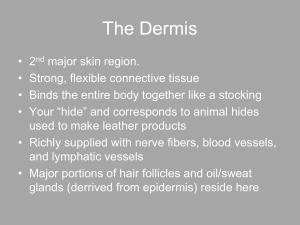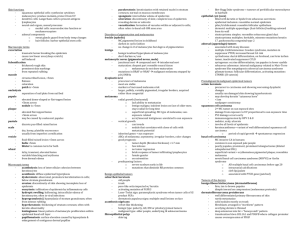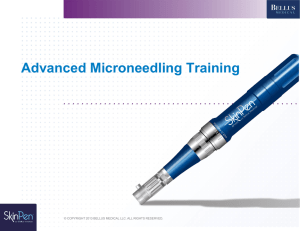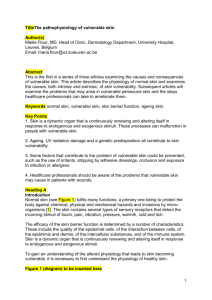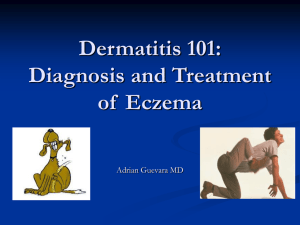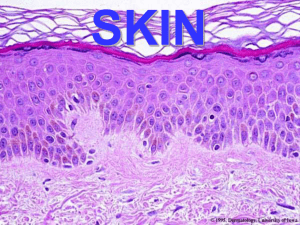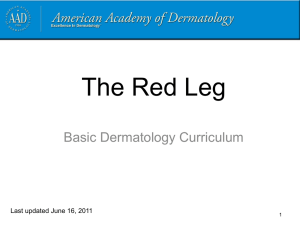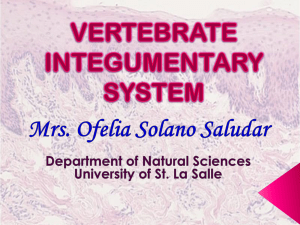File - Mark R. Wick, MD
advertisement
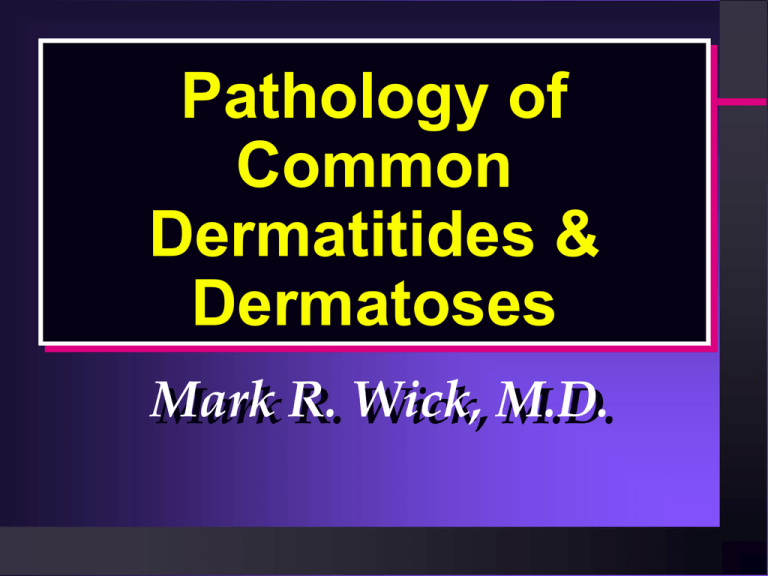
Pathology of Common Dermatitides & Dermatoses Mark R. Wick, M.D. “Papulosquamous” Dermatitides Defined by clinical attributes, as slightly elevated papular eruptions with scaling These diseases include spongiotic, lichenoid, and psoriasiform dermatitides from a pathological perspective “Papulosquamous” Dermatitides: Common Representative Examples 1. 2. 3. Spongiotic dermatitides Contact dermatitis Eczema (atopic dermatitis) Superficial mycoses (dermatophytoses) Seborrheic dermatitis (acute/subacute) Pityriasis rosea Selected cases of secondary syphilis Lichenoid dermatitides Lichen planus Lichen simplex chronicus (“neurodermatitis”) Lupus erythematosus (discoid or systemic) Dermatomyositis Psoriasiform dermatitides Psoriasis vulgaris ANY CHRONIC SPONGIOTIC DERMATITIS SPONGIOTIC DERMATITIDES Spongiotic Dermatitides: General Histologic Features 1. 2. 3. Variable parakeratosis: retention of nuclei in superficial cornified epidermal cells Spongiosis: Presence of edema fluid between individual epidermal cells, which may progress to formation of vesicles (microscopic intraepidermal “blisters”) Inflammation in the epidermis and dermis, with perivascular dermal accentuation. It is usually chronic in nature (i.e., featuring lymphocytes and histiocytes), but small numbers of neutrophils & eosinophils may also be observed Spongiotic Dermatitides: Histologic Nuances 1. 2. 3. 4. 5. Allergic Contact Dermatitis: Eosinophils in the epidermis Seborrheic Dermatitis: Accentuation of parakeratosis around hair follicle ostia, with or without neutrophils Pityriasis rosea: Extravasation of red cells in the epidermis Dermatophytoses: Neutrophils in the epidermis, along with intracorneal PMNs; fungi are visible with the GMS stain Syphilis: Spirochetes in epidermis with the Warthin-Starry/Steiner silver stains LICHENOID DERMATITIDES Lichenoid Dermatitides: General Histologic Features 1. 2. 3. 4. Damage to basal epidermal keratinocytes, with secondary “vacuolar” (clear-cell) change in their cytoplasm Infiltrate of lymphocytes + plasma cells in a “band” beneath the epidermis, with or without direct involvement of the dermoepidermal junction Death of keratinocytes near the stratum basalis, with formation of “cytoid” bodies Variable atrophy or hyperplasia (acanthosis) of the epidermis Lichenoid Dermatitides: Histologic Nuances 1. 2. 3. Lichen Simplex Chronicus: Vertical striation of collagen surrounding the rete ridges, in the papillary dermis Lichen planus: Irregular “sawtooth” hyperplasia of the epidermis with irregular thickness of the stratum granulosum and a lack of parakeratosis Lupus erythematosus/Dermatomyositis: Atrophy of the epidermis with thickening of the epidermal basement membrane; LE also shows dermal mucin deposition PSORIASIFORM DERMATITIDES Psoriasiform Dermatitides: General Histologic Features 1. 2. 3. 4. 5. Regular acanthosis of the epidermis, but with suprapapillary thinning Parakeratosis and/or orthokeratosis Variable acute inflammation, especially involving the epidermis & stratum corneum (“Munro” & “Kogoj” microabscesses) Perivascular chronic dermal inflammation Papillary dermal hypervascularity Psoriasiform Dermatitides: Histologic Nuances 1. There are NO specific markers of psoriasis vulgaris; Munro & Kogoj microabscesses may be seen in other diseases as well, particularly in chronic dermatophytoses 2. “Suggestive” histologic features of acute or subacute spongiotic dermatitis are usually ABSENT in their chronic forms, yielding microscopic images which simulate that of psoriasis closely. Resulting differential diagnosis includes psoriasis, chronic eczema, chronic dermatophytosis, and chronic contact dermatitis PRIMARY ACQUIRED BULLOUS DISEASES OF THE SKIN Primary Acquired Bullous Diseases of the Skin Pemphigus vulgaris Bullous Pemphigoid Epidermolysis bullosa acquisita Dermatitis herpetiformis Primary Acquired Bullous Disorders of the Skin: Models of Autoimmune Disease Disease Autoantibody Target(s) Pemphigus vulgaris Plakoglobin-130kD complex in epidermal desmosomes Pemphigoid BP antigen in the lamina lucida of the epidermal BMZ Epidermolysis EBA antigen in sub-lamina bullosa acquisita densa zone of epidermal BMZ Dermatitis Dermal papillary collagen (& herpetiformis gliadin/endomysial proteins) Primary Acquired Bullous Disorders of the Skin: Histologic Features 1. 2. 3. 4. Pemphigus vulgaris-- Intraepidermal blisters, centered in the suprabasal region; sparse mixed acute & chronic inflammation Pemphigoid-- Subepidermal blisters, filled & undermined by PMNs, eosinophils, & lymphocytes EBA-- Essentially identical to pemphigoid Dermatitis herpetiformis-- Dense regional dermal infiltrates of PMNs, most notable in upper dermal papillae & within blisters Primary Acquired Bullous Disorders of the Skin: Direct Immunofluorescence Disease Pemphigus DIF Pattern Intercellular labeling for IgG, IgM, C’3 in epidermis Pemphigoid/EBA Linear labeling of epidermal BMZ for IgG, IgM, C’3; collagen type IV in blister floor in BP & in blister roof in EBA Dermatitis herpetiformis Interrupted linear/granular labeling of epidermal BMZ for IgA, C’3 SELECTED VASCULAR ABNORMALITIES OF THE SKIN Leukocytoclastic Vasculitis: Pathologic Features Synonymous with “small vessel vasculitis,” “hypersensitivity vasculitis,” or “Zeek’s vasculitis.” May be associated with underlying collagen vascular disease, Henoch-Schoenlein disease, or malignancy. Microscopic diagnosis is based on: Neutrophilic infiltration of small venules in dermis, with karyorrhectic basophilic nuclear “dust” in interstitium Extravasation of erythrocytes in the dermis Fibrinoid change in vessel walls is often seen but not diagnostically necessary Urticarial Reactions: Microscopic Features Principal histologic alteration is dermal edema, relating to “leakiness” of capillaries in the corium during reactions featuring local hyperhistaminosis Dermal collagen bundles are splayed apart, by seemingly empty spaces Variable numbers of eosinophils and neutrophils are seen around dermal venules & capillaries Urticarial vasculitis is defined histopathologically as an “amalgam” of urticaria and leukocytoclastic vasculitis
